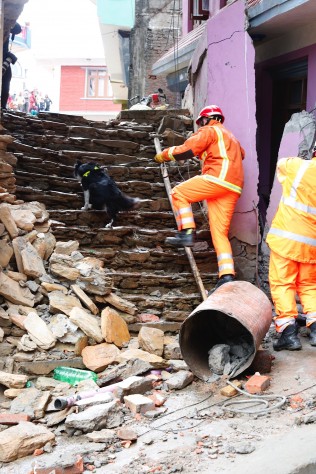On Saturday, April 25, 2015, an earthquake of magnitude 7.8 on the Richter scale devastated Nepal. With damages cost estimates looking to exceed 20% of the country’s GDP, the recent earthquake has also left in its wake a death toll of at least 8,000 people so far and laid waste to vast areas of land and structures.
So what does this all mean for Nepal’s tourism economy?
With close to 800,000 tourists entering the country in 2013, tourism is a booming business for the region, making up from 3 to 8.2% of the nation’s gross domestic product, depending on the year. Indeed, with a predominantly mountainous landscape and an economy heavily reliant on agriculture, Nepal is quite reliant on its foreign visitors to keep the economic pistons pumping.
However, even in the aftermath of a significant earthquake, a primary and very real danger comes from the threat of landslides and avalanches. Mountainous areas typically see a rapid increase in landslide activity after an earthquake, and with the Nepal monsoon season fast approaching, the combination could make for an extremely dangerous situation
Nepal is already a country prone to landslides, yet despite the reports from Tibet officials of landslides across the border, the Chinese closure of the north sides of Everest, and the devastation of Everest Base Camp, the Nepalese officials still claim no current plans to withhold expeditions.
In addition, between the splash caused by any occurring landslide or avalanche and the possibility of weakened glaciers or moraines, an outburst of one of the many glacial lakes in the Himalayan Region puts the surrounding villages and the hydroelectric plants in additional peril for flooding.
Nepal plays host to seven of the United Nation’s World Heritage sites. Unfortunately, the quake was not choosy in its destruction and has left four of those sites significantly damaged, including Patan, Bhaktapur, the Durbar Squares of Kathmandu, and Sagarmatha National Park, home to the great Mount Everest. Ancient temples, which were once a great draw for visitors, now lay significantly damaged or completely crumbled, wounding the physicals manifestations of Nepal’s uniquely blended cultural heritage of both Hinduism and Buddhism.
Many of the major hotels, if they remain intact, are marred with large cracks or have become structurally unsound. The primary airport in Nepal is still a chaotic scene, with physical damage to the buildings and runways, and masses of people looking to escape the area camping all around the airport, urgent to depart. With regards to inbound planes, only those carrying relief supplies or doctors are being allowed into the airport.
Tourism has been a blessing for the cash-poor Nepal, a country still recovering from decades of political turmoil and civil unrest. In the wake of this recent natural disaster, who can say how long it will take to recover some semblance of normality? Some optimists hope to see a return of backpackers and hikers as soon as next October, while others are more skeptical of such a quick turn around.
For those interested in contributing to the ongoing relief efforts, we’ve compiled a comprehensive list of opportunities to do so.
UPDATE: A second earthquake struck Nepal on Tuesday, May 12, just a few weeks after the original earthquake on April 25. The second quake was measured at a magnitude of 7.3 and resulted in several smaller aftershocks. Its epicenter was near Dolakha, which lies about 47 miles northeast of the capital city of Kathmandu. The second earthquake has resulted in further chaos and destruction for areas previously left in ruin and affected the ongoing efforts of relief personnel trying to assist in response to first quake. The total death toll for the seismic events has now reached well over 8,000, with additional injuries currently estimated around 1,000.
Read Ethical Traveler's Reprint Policy.

